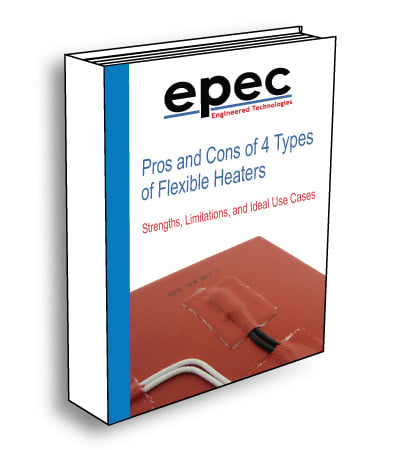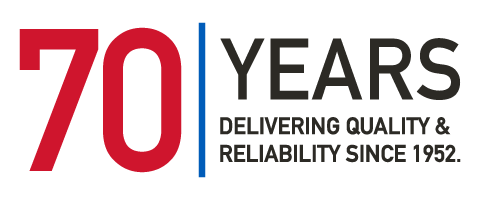Flex Heater Elements
Foil element choice will be determined by your heater profile. A heater profile can be determined through experimentation with standard heaters and your desired thermal needs. The heaters should be arranged at varying power levels to determine optimum temperature gradient across the entire surface. By profiling and determining where heating losses need to be compensated, we can match the most efficient profile with a single element.
There are two common types of flexible heaters: the older wound-wire devices and foil-based devices. Both use metals with different resistivity and heating characteristics.
Wire heaters use a single or several strands of wire to transfer heat to a tangent point or arc area of its circular heating element. In contrast, the flat surface of foil heaters provides more uniform heating thanks to significantly more surface area devoted to heat transfer.
Find out more, Flexible Heater Elements: Differences and Advantages.
Stainless Steel 304
With etched foils, Stainless Steel 304 is standard. It has a minimum of 18% chromium and 8% nickel, combined with a maximum of 0.08% carbon. Along with excellent forming properties, stainless steel 304 is corrosion/oxidation resistant thanks to its chromium content. Stainless steel 304 is an excellent heat exchanger with elevated temperatures due to its higher carbon content.
| Typical Physical Properties | |
|---|---|
| Density (g/cm3) | 8.0 |
| Electrical resistivity at 20°C (Ωmm2/m) | 0.68 |
| Temperature factor of resistivity (20°C~600°C) x 10-5/°C | -6 |
| Conductivity coefficient at 20°C (WmK) | 17 |
| Maximum Temperature: Mechanical | 420°C |
| Coefficient of Thermal Expansion | |
| Temperature | Thermal Expansion x 10-6/K |
| 20°C - 400°C | 16 |
| Specific Heat Capacity | |
| Temperature | 20°C |
| J/gK | 0.48 |
CuNi44
The copper-nickel alloy CuNi44 is also offered. CuNi44 is characterized by high electrical resistance, high ductility, and good corrosion resistance. It is suitable for use at temperatures up to 400°C.
| Typical Physical Properties | |
|---|---|
| Density (g/cm3) | 8.9 |
| Electrical resistivity at 20°C (Ωmm2/m) | 0.49 |
| Temperature factor of resistivity (20°C~600°C) x 10-5/°C | -6 |
| Conductivity coefficient at 20°C (WmK) | 23 |
| Maximum Temperature: Mechanical | 600°C |
| Coefficient of Thermal Expansion | |
| Temperature | Thermal Expansion x10-6/K |
| 20°C - 400°C | 15 |
| Specific Heat Capacity | |
| Temperature | 20°C |
| J/gK | 0.41 |
Inconel600
We also offer Inconel600 as a heating element which offers the highest resistance with no magnetic properties. It is an austenitic alloy with a high nickel content. The high nickel content of the alloy provides good resistance to reducing environments while the chromium content provides resistance to weaker oxidizing conditions.
| Typical Physical Properties | |
|---|---|
| Density (g/cm3) | 8.5 |
| Electrical resistivity at 20°C (Ωmm2/m) | 1.03 |
| Temperature factor of resistivity (20°C~600°C) x 10-5/°C | -6 |
| Conductivity coefficient at 20°C (WmK) | 15 |
| Maximum Temperature: Mechanical | 1100°C |
| Coefficient of Thermal Expansion | |
| Temperature | Thermal Expansion x10-6/K |
| 20°C - 400°C | 13 |
| Specific Heat Capacity | |
| Temperature | 20°C |
| J/gK | 0.46 |
Optimize Your Heating Performance Today!
Don't let inefficiencies hold you back. Perfectly profile your heating needs and choose the most effective foil element tailored to your requirements. Dive deep into the unique characteristics of Stainless Steel 304, CuNi44, and Inconel600, and elevate your heat transfer game. From uniform heat distribution to resisting challenging environments, make the right choice for maximum efficiency.
Request a Quote Request Design Support Request More Information


